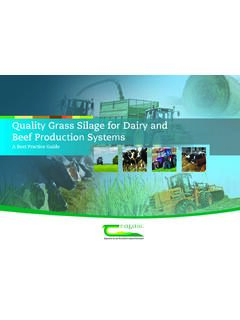Transcription of Control of lungworm in cattle - COWS
1 cows lungworm | August 2014 | 1 Control of lungworm in cattle This document is part of the cows Technical Manual aiming to provide a sound basis for advice to industry. The manual also comprises chapters on controlling liver and rumen fluke, parasitic gastroenteritis, ectoparasites and insect pests, and integrated Control of parasites on cattle farms cows is an industry initiative promoting sustainable Control strategies for parasites in cattle cows lungworm | August 2014 | 2 Section 1: Top 10 tips for controlling lungworm (parasitic bronchitis) Identify Risk 1.
2 lungworm outbreaks are unpredictable, but are more prevalent in wetter, western areas of Britain. In endemic areas, younger cattle are at risk until they acquire immunity through exposure to lungworm larvae. 2. Suspect lungworm infection if there is coughing or respiratory distress in grazing cattle , particularly first-season grazing calves, at grass. 3. Animals exposed to lungworms usually develop resistance to re-infection. Lack of exposure may result in clinical signs occurring in older cattle , including milking cows . Previously immune animals may exhibit signs if immunity wanes, or pasture infectivity is high.
3 4. Quarantine and treat all incoming cattle for roundworms and fluke (see cows Liver Fluke section tip 9 and the cows Integrated Parasite Control chapter). Bought in calves or adult cattle may introduce lungworm onto a farm. Most anthelmintics used for Control of gut roundworms are effective against lungworms. Check with your vet or Suitably Qualified Person (SQP). Treat Appropriately 5. Routine vaccination should be considered for calves born into herds with an identified lungworm problem or when there is a previous history of lungworm on the farm. Once a vaccination program is started, all first year calves should be vaccinated and this continued annually for each calf crop.
4 6. Vaccination is not justified in low-prevalence regions, or on farms with no previous history of lungworm . 7. Anthelmintics can be used strategically in first-year grazing cattle to prevent build-up of lungworm larvae on pasture over the grazing season. As overuse of anthelmintics may potentially limit exposure to lungworm larvae to such an extent that cattle remain susceptible to infection, it may be advisable to consider vaccination prior to their second year at grass. 8. Prognosis will vary according to the severity of the disease and deaths may occur despite anthelmintic treatment. In animals with respiratory distress avoid orally administered anthelmintics.
5 9. Severely affected animals may require additional supportive treatment, which should be discussed with your vet. Plan Ahead 10. Work out a Control strategy. lungworm outbreaks can cause severe losses and even death in cattle . This can happen at relatively low pasture infection levels. Farms with a previous history of lungworm should consider vaccination as an integral part of their overall worm Control strategy as part of herd health planning. cows lungworm | August 2014 | 3 Dairy calves are most commonly affected Section 2: lungworm (Parasitic Bronchitis, Dictyocaulosis, Husk , Hoose )Parasitic bronchitis (husk) is an economically important parasite infection of the bovine respiratory tract caused by the nematode, Dictyocaulus viviparus.
6 This species mainly affects cattle , but has also been reported in other ruminants, such as deer. The parasite is widespread, but infections are more prevalent in wetter areas, particularly those in the west of the British Isles. Losses in severe lungworm outbreaks in growing cattle can average 50- 100 per head and lost milk production in adults may reach 3 per cow per day. As with many other parasitic nematodes, infection is acquired by the ingestion of infective larvae from pasture. The epidemiology is complex and outbreaks are often unpredictable.
7 Symptoms are most commonly seen in first-year grazing cattle in late summer and autumn, but can occur earlier in the year and in older animals. The most characteristic clinical sign of lungworm infection is widespread coughing within a herd. Mortality occurs in heavy infections. Although dairy or dairy-cross calves are most commonly affected with lungworm , autumn-born single-suckled beef calves are just as susceptible when turned out to grass in early summer. Spring-born suckled beef calves grazed with their dams until housed or sold do not usually develop clinical signs, although coughing due to a mild infection is common.
8 However, typical disease may occur in weaned beef calves grazed until late autumn. Animals exposed to lungworms usually develop resistance to re-infection. Lack of exposure in young cattle may result in clinical disease occurring in older cattle . Sudden heavy pasture larval challenge, due to prevailing weather conditions, may lead to clinical signs of re-infection husk (see section 5). Key Concerns Severe losses in disease outbreaks Reduced milk yield in adult cows Complex, unpredictable epidemiology Deaths can occur despite anthelmintic treatment cows lungworm | August 2014 | 4 Larvated egg containing L1 Section 3: The parasiteAdult worms are slender and thread-like and measure 4-8cm in length.
9 The sexes are separate. Life Cycle The life cycle is similar to that of the gastrointestinal nematodes except that eggs, containing first-stage larvae (L1) are coughed up and swallowed and then hatch during passage through the digestive tract. The L1 present in freshly-voided faeces, are characteristically sluggish and their intestinal cells are filled with dark brown food granules. The pre-parasitic stages do not need to feed. Under optimal conditions the L3 stage is reached within 5-7 days, but this may take longer depending on the environmental conditions.
10 The L3 leave the faecal pat to reach the herbage through their own movements or by airborne spread utilizing the fungus, Pilobolus. After ingestion, L3 penetrate the intestinal mucosa and pass to the mesenteric lymph nodes where they moult. The L4 then travel via the lymph and blood to the lungs, and break out of the capillaries into the alveoli about one week after infection. These migrate up the lungs and moult to L5, becoming mature adults between three and four weeks after infection, when L1 can be detected in dung.
